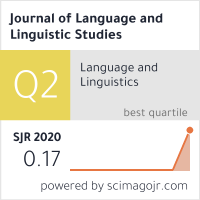ADJECTIVAL OR ADVERBIAL? THE USE OF MOVABILITY AND RELATIVE CLAUSES TO AVOID A PREPOSITIONAL PHRASE ATTACHMENT AMBIGUITY
Abstract
This study is intended to help English foreign language learners avoid a type of syntactic ambiguity in sentences resulting from prepositional phrases (PPs). The students are guided to make use of the features of both adverbials and adjectivals in resolving this type of ambiguity. The movability of adverbials and the use of relative clauses instead of adjectival prepositional phrases are the two tricks that have helped students construct comprehensible sentences. The study avoids the use of syntactic tree diagrams since the relation among the words of the sentence should be clear before applying or drawing the syntactic tree diagrams. The students are given two assignments: the first after an introduction to the form and functions of PPs and the second after detailed instructions about the functions of PPs and how they can be a source of ambiguity in a sentence. This paper seeks to provide a practical solution to help learners avoid constructing ambiguous PPs. When people can infer more than one meaning, this ambiguity is considered a linguistic problem since language is used mainly to communicate thoughts and messages among people (Sturta, et al., 2003).
Keywords
Full Text:
PDFReferences
Bailey, D., Lierler, , Y., & Susman, B. (2015, April 14). Prepositional phrase attachment problem revisited: How VERBNET can help. Omaha: University of Nebraska.
Cann, R. (1993). Formal semantics: An introduction. Great Britain: Cambridge University Press.
Cehann, N. (2019). A corpus view on a couple of structurally ambiguous sentences: Romanian Journal of English Studies. DOI: 10.1515/RJES-2019-0010.
Conway, P. “Syntactic Ambiguity.” The law and justice foundation of NSW. March 14, 2002. http://www.lawfoundation.net.au/ljf/site/articleIDs/63B6C5E2ABB6A511CA25714C000CFF37/$file/syntactic.pdf
Duan, M., Hill, E., & White, M. (2016, January). Generating disambiguating paraphrases for structurally ambiguous sentences. Conference Paper. USA: The Ohio State University, Department of Linguistics.
Irawan, W. B. (2009). An analysis of ambiguity in the articles of the Jakarta Post. Sebelas Maret University, Faculty of Letters and Fine Arts, English Department. https://core.ac.uk/download/pdf/16507098.pdf
Jha, K. S. (2017). Exploring ambiguous structures in English. Global Journal of Interdisciplinary Social Sciences: Global Institute for Research & Education, 6(3):1-4
Kadlub, M. (2017). Sources of ambiguity in language: Studia Anglica Resoviensia, 14(4).
Kempson, R. M. (1977). Semantic Theory. Great Britain: Cambridge University Press.
Khawalda, M. I. & Al-Saidat, E. M. (2012, March). Structural ambiguity interpretation: a case study of Arab learners of English. Global Journal of Human Social Science, 12(6).
Lee, J. W., Kim, S., k Chae, J., Lee, J. & Kim, D. (2003, August). English syntactic disambiguation using Parser’s ambiguity type information. Etri Journal, 25(4):219-230
MacDonald, M. C., Pearlmutter, N. J., & Seidenberg, M. S. (1994). The lexical nature of syntactic ambiguity resolution. Psychological Review, 101(4), 676–703. https://doi.org/10.1037/0033-295X.101.4.676
Merrick, D. (2007). Targeting grammar, upper primary. Blake Education Pty Ltd.
Montrose, J. (1962). SYNTACTIC (FORMERLY AMPHIBOLOUS) AMBIGUITY. MULL: Modern Uses of Logic in Law, 3(2), 65-71. Retrieved March 15, 2021, from http://www.jstor.org/stable/29760881
Nadh, K. and Huyck, C. (2009). Prepositional phrase attachment ambiguity resolution using semantic hierarchies. London, UK: Middlesex University, School of Computing Science.
Nordquist, Richard. (2021, February 16). What is parsing? Definition and examples in English grammar. Retrieved from https://www.thoughtco.com/parsing-grammar-term-1691583
Sturta, P., Costab, F., Vincenzo Lombardoc, V., & Paolo Frasconi, P. (2003). Learning first-pass structural attachment preferences with dynamic grammars and recursive neural networks. Cognition 88: 133–169.
Traffis, C. (2021). What is a prepositional phrase. https://www.grammarly.com/blog/prepositional-phrase/?gclid=Cj0KCQiAvP6ABhCjARIsAH37rbQx_L4dCZtDLdSMyH0hs3olHnnox7f2A8b74m_oxM47-bfT9NQAvfoaAlSeEALw_wcB&gclsrc=aw.ds
Tsai, y. (2012). Investigating syntactic ambiguity resolution strategy use of EFL learners in reading relative clauses. Arab World English Journal, 3(3): 57-77.
Yang, L. (2014). The disambiguation and application of the English syntactic ambiguity. International Conference on Education, Language, Art and Intercultural Communication (ICELAIC 2014). China: Atlantis Press.
Refbacks
- There are currently no refbacks.

This work is licensed under a Creative Commons Attribution-NonCommercial-NoDerivatives 4.0 International License.
ISSN 1305-578X (Online)
Copyright © 2005-2022 by Journal of Language and Linguistic Studies
